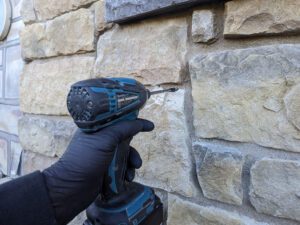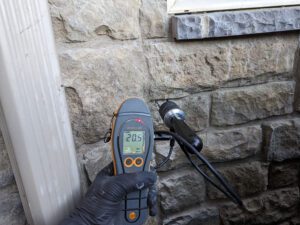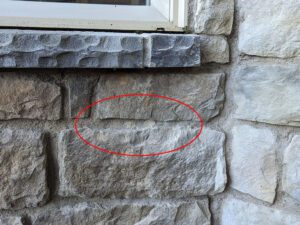Stone Veneer Inspections
Stone Veneer and Stucco Inspection Information and Procedure
Adhered Concrete Masonry Veneer (ACMV), or Adhered Stone Veneer (ASV), often called cultured stone has been around for several decades now. It started being really popular in the early 2000s and continues to be a very popular choice of building materials for new construction to add a touch of class and upgrades to the home's curb appeal and appearance. It looks nice, it's light, is not super expensive like real stone, is pretty easy to install, so it's a great thing right? Yes, it is a great thing, HOWEVER, most stone veneer is installed incorrectly. After inspecting hundreds of stone installation, it's obvious that the industry best practices often get overlooked or ignored.
Industry Guidelines for Stone Veneer and Stucco Inspections
There is a stone veneer industry guide published and updated regularly by the National Concrete Masonry Association (NCMA) that details the best practices and correct installation of stone veneer. The most current version (5th Edition) is published and available for download from this page: National Concrete Masonry Association Guides and Manuals page. The direct link to the stone veneer installers guide PDF file is available here: MVMA Installation Guide.
These installation guidelines are the standards that we inspect to. The vast majority of new and existing installations we inspect are incorrectly installed per industry guidelines. Keep in mind, however, that older installations may not have had as much guidance and installation requirements as they do today, so the best we can do with older installations is to look at issues that are definitely a problem, or a potential future problem, which are currently or may result in moisture issues with the structure. New and recent installations within recent years should adhere to the published industry guidelines unless there is something in the manufacturer's installation instructions that indicate otherwise.
Common Defects with Stone Veneer and Stucco
When inspecting stone veneer installations, the most common deficiencies we note are lacking proper clearance from grade or hardscape (sidewalks, patios, driveways), no weep screed at the base of the assembly, lacking or improper flashing, no casement and sealant bead at transitions from stone to other materials such as door jambs, window trim, and siding. As with all wall cladding, the most common areas for water intrusion is at penetrations through the wall such as windows, doors, and utility penetrations like hose bibs, lights, etc. Penetrations lacking proper clearance, flashing, and sealant can result in water penetration, mold and rot of the wall structure, and costly repairs.
Inspection Procedure
First, a visual inspection is conducted and any deficiencies are documented. Deficiencies could include such things as lack in clearance from hard and soft grade, lack of, or incorrect flashings, holes or gaps in mortar, failed sealant joints, lack of sealant joints and more. Critical areas such as kickout flashing areas or below windows, and any areas having visual indications of moisture intrusion are selected for moisture probing.
It is impossible to determine the condition of the wall sheathing under the stone or stucco without inserting moisture probes and taking moisture measurements. At each moisture probe site, two small 1/4 inch holes are drilled, moisture probes are inserted to measure moisture content in the wall sheathing, the sheathing is probed to determine if softness or decay exists, and the holes are filled with silicone as closely as possible matching the color of the mortar.
1/4 inch holes drilled in stone mortar joint |
|
|
Moisture probing performed |
|
|
Holes filled with sealant |
|
|
Measurement locations are documented and a detailed report will be produced and delivered including any areas where damage is located.
Get answers from an Inspection Specialist
Give us a call today to answer any questions you have regarding home inspections, Radon testing, or sewer line inspections.
We're Certified Inspectors


Schedule an Inspection Today
We are ready to schedule an inspection for you. Click the button and you can choose your date and time and do everything online. Or give us a call and we can schedule it for you.



